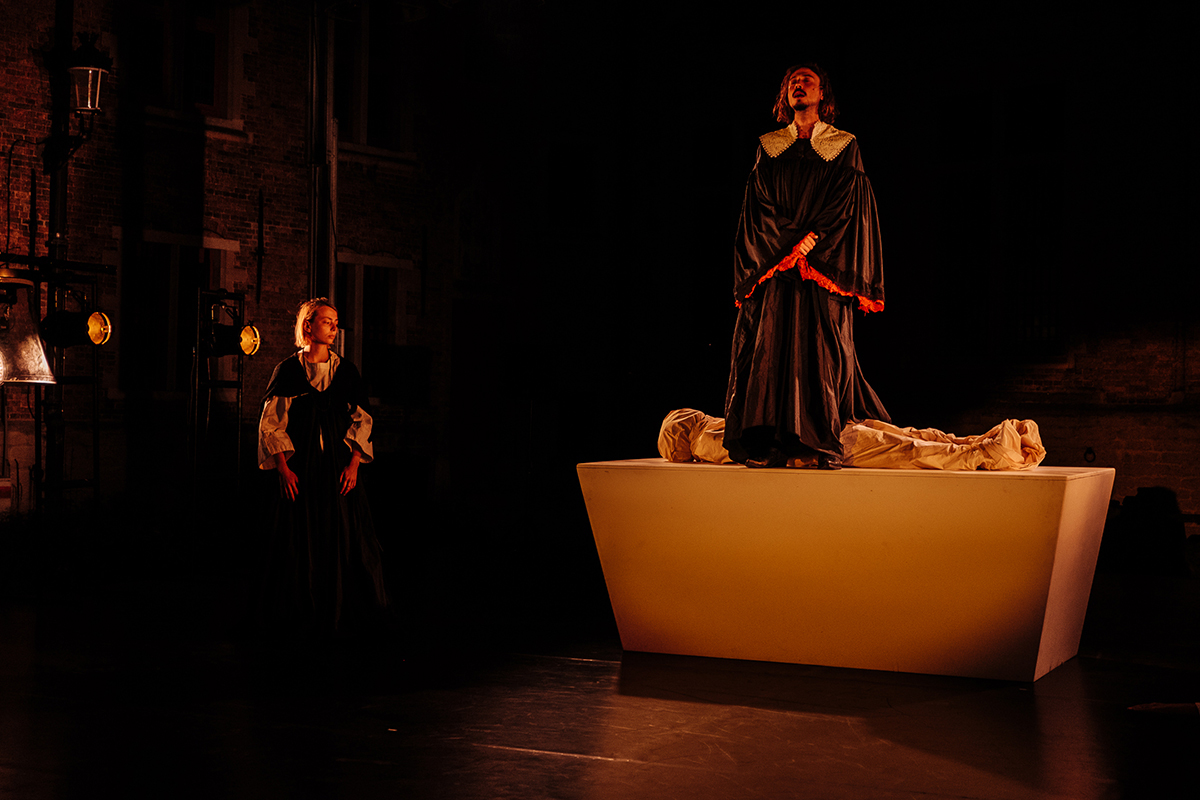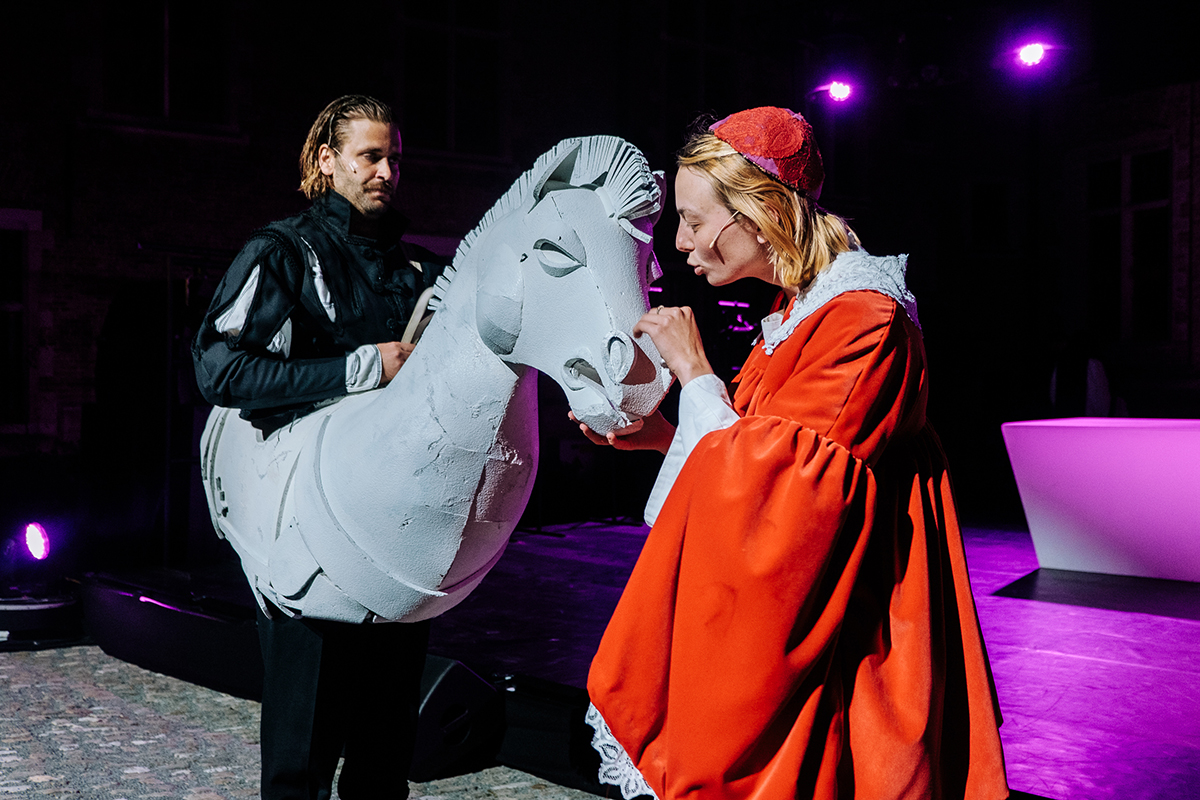The year is 1632. Early modern France is in recovery from plague epidemics and religious wars that have caused chaos, famine, and division across the country. The Catholic Church, in response to the Protestant Reformations, has been tightening the reigns and conducting a purification of its faith and its subjects. Cardinal de Richelieu, who is Prime Minister of France under King Louis XIII at the time, battles against independent national factions that obstruct a powerful centralised state.
In that same year, the French city of Loudun is startled by a gulf of demonic mass hysteria. The nun Jeanne des Anges, abbess of the town’s Ursuline convent, claims to be possessed by the devil. Soon her 17 fellow nuns become infected by the same demon. The nuns point to the progressive, sexually promiscuous priest Urbain Grandier as the perpetrator. The well-spoken Jesuit priest was already persona non grata at the Paris court after his resistance against the demolition of the city walls, a state order that had been assigned to superintendent Jean Martin de Laubardemont. By request of Richelieu, Laubardemont investigates the demonic case in an attempt to silence Grandier. After a merciless show trial, the priest ends up on the stake.

Novelists and historians alike have been investigating the possession of Loudun for centuries. Philosopher Michel De Certeau described the bizarre events as a complex piece of political theatre. ‘The exorcisms were transformed into a grand public process: a confrontation between religion and science, a debate on what is certain and uncertain, about reason, about the supernatural and about authority. It was a ‘theatre’ that drew curious onlookers from across Europe.’
According to Krapp, the Loudun case resonates particularly with our own time, now that political paranoia, conspiracy theories and religious rhetoric are increasingly used as mediagenic strategies to frame and brand minorities. The trial pushed all the involved parties into specific, theatrical roles that could be both emancipatory and destructive. In that sense, both the possessed nuns and the accused Grandier became actors in a grand political play that broached brand-new societal questions.
The events in Loudun put into sharp relief how new ideas often go hand in hand with reactionary outbursts. In times of major transition – of scientific revolution and of early enlightened thinking – forgotten devils resurfaced; stronger, more powerful, and more conservative than ever.
Urbain Grandier, who openly opposed celibacy for priests and raved fiercely against the authoritarian regime of the French monarchy, was reduced to a diabolical wizard. And in a time when women were systematically oppressed, when witch burnings and femicide ran rife, the possessed nuns had to take on the role of a (male) demon in order to ‘safely’ vent about their permanent state of oppression. Although ‘possession’ is traditionally seen as a state of complete loss of control, De Certeau calls the demonic possessions of the involved nuns ‘a rebellion of Amazons’. He believes that the possession is just as much ‘a revolt by women: women who are aggressive and provocative, and who, through exorcisms, get to communicate their most suppressed desires and needs for the first time’.

Nona Demey Gallagher takes on the direction of De Duivels / Les Diables. Timo Sterckx plays Urbain Grandier. Mats Vandroogenbroeck wrote a new theatre text based on historical materials, from novels and case files to accounts from spectators, exorcists, victims and accused. Various fictional side lines are woven into the story, inspired amongst others by research by the academic Silvia Federici, in order to more actively illustrate the motivations of the female characters.
De Duivels / Les Diables is Krapp’s third creation. They previously created Weird Tales (2021) and Through The Looking-Glass (and what we found there) (2019).

Mats Vandroogenbroeck (°1993, he/him) is an actor, theatre creator and writer who studied History at UGent and Drama at KASK.
Mats has worked as an actor and creator at, amongst others, de Kopergietery, studio ORKA, Blauwhuis, Malpertuis, Compagnie de Koe and artist collective ZUIDPARK. With Jonas Baeke he recently created the children’s theatre performance Bambiraptor, which was selected for the Theaterfestival (2022).
Besides his work as an actor, Mats is working on an artistic and critical writing practice. He is an editorial member of cultural and critical magazine rekto:verso and writes the texts for Krapp, his theatre collective with classmates Nona Demey Gallagher and Timo Sterckx. His fascination for the occult is a recurring theme in his theatre work. With their absurdist text for the creation Through the Looking-Glass (and What We Found There), Krapp won the SABAM Jong Theaterschrijfprijs (a prize for young writers) at Theater Aan Zee (2019).


Nona Demey Gallagher (°1995, she/her) is a theatre creator. She graduated with a master’s degree in drama from KASK Ghent. She has collaborated amongst others with Ontroerend Goed (Loopstation), KOPERGIETERY and Beeldsmederij De Maan (plastiekBERTRAND), DE Studio (Dreaming Not Sleeping) and CAMPO / De Koe (In Koor!).
With Mats Vandroogenbroeck and Timo Sterckx, she makes up the theatre collective Krapp. They created Through The Looking-Glass (and what we found there), which won the Theatre Writing Prize at Theater Aan Zee #19, and Weird Tales, a feminist horror film on stage about the life of Mary Shelley, in which Nona played the writer herself.
Besides theatre, Nona has also studied Flemish sign language at Doof Vlaanderen. She created the performance E R O T I C A together with Imke Mol, in which they translate erotic poetry by female authors into Flemish sign language. In 2023 Nona is directing Krapp’s new creation De Duivels / Les Diables, as well as her upcoming radical feminist project Up Your Ass at Campo.

Body / Mind
With his famous proposition ‘Cogito, ergo sum’ — ‘I think, therefore I am’ — the French philosopher René Descartes radically separated the mind from the body at the start of the 17th century. Within his mechanistic philosophy, reason became the protagonist, while the body became a dehumanised machine full of passions that could only be controlled and neutralised by reason. The idea that the rational mind is the central tenet of humanity legitimised both the power of God and the distinctions between classes, races, and sexes. Like the labourer and the slave, woman was an irrational being that was too mentally weak to control her subversive passions and humours.
In a France plagued by pestilence and religious wars, the body became a political instrument to subjugate labourers and women in order to stimulate population growth, consolidate the power of the church and increase state capital. Within this thinking, female diseases like hysteria were supposedly caused by a wandering uterus: a wild and untrustworthy organ that was best tamed through marriage. Church and state instated strict rules around reproduction, marriage and contraception, and women were reduced to reproductive machines. The female body became a matter of state, and their ancient knowledge of nature was scandalised – especially midwifery, alternative medicine, and herbalism.
Witch / Saint
Throughout the 16th and 17th centuries, women lost nearly all of their societal freedoms. Women without a family, prostitutes, single mothers, and midwives were especially regarded with distrust. The image of the witch became increasingly prevalent: often an elderly, lone woman who lived in poverty or had withdrawn into nature. Witches were seen as promiscuous and rebellious women who copulated with the devil during hedonistic sabbath rituals and bewitched men to corrupt their minds and undermine their authority. Witches became state enemy number one, and hundreds of thousands of women were burned at the stake, hung, or tortured. They were condemned for, amongst others, contraceptive magic, sodomy, murdering children, and worshipping animals. After the peak of witch burnings, at the end of the 17th century, the image of women changed gradually. The prototype of women as virtuous and innocent took shape, a period sometimes called ‘the century of the saints’. These canonisations happened mainly to (religious) women, after a turbulent period of demonisation and witchcraft. A possessed woman would endure the torture of exorcism as a form of martyrdom, a noble offering that must be made to become a saint. Public exorcisms also served as an example: the absolute power of the church was demonstrated as a clear victory of faith and purity over heresy and rebellion.

Timo Sterckx (°1995) is a theatre creator and actor. He studied Drama at KASK Ghent.
After his studies he kick-started his career with De Roovers as well as with Louis Janssens and Ferre Marnef in Toverberg, their second collaboration after #BOS. He previously created The Greatest Show on Earth with Louis, a performance for which Timo learnt an entire book by heart.
He makes up collective Krapp with Mats Vandroogenbroeck and Nona Demey Gallagher. They created Through the Looking Glass (and What We Found There), which was awarded the Theaterschrijfprijs at TAZ#19, followed by Weird Tales. Besides his own creations, Timo has performed in projects by Myriam Van Imschoot/Cie De Koe, Theater Malpertuis, and Julie Cafmeyer. Timo’s own work has been selected for the Theater Aan Zee prize four times. He is set to appear in new creations by Bruno Vanden Broecke and WOLF WOLF.
















Credits
CONCEPT Mats Vandroogenbroeck, Nona Demey Gallagher, Timo Sterckx (KRAPP) PERFORMANCE Mats Vandroogenbroeck, Timo Sterckx, Fleur Perneel, Bastiaan Vandendriessche, Maria Zandvliet, Fiene Zasada, Matthias Van de brul TEXT Mats Vandroogenbroeck DIRECTION Nona Demey Gallagher DRAMATURGY Dina Dooreman COSTUMES Eleni Ellada Damianou PAINTING Emiel Vandekerckhove MUSIC Lukas De ClerckCOACHING Valentijn Dhaenens LIGHT DESIGN & DIRECTION Dimi Stuyven SOUND DESIGN & ENGINEER Bram Moriau TECHNICAL PRODUCTION & STAGE MANAGER Lieven Symaeys SURTITLING Inge Floré TRANSLATION Trevor Perri, Anne Vanderschueren PRODUCTION MANAGER Catherine Vervaecke ARTWORK POSTER Anton Claeys DISTRIBUTION Saskia Liénard PRODUCTION KRAPP & KVS COPRODUCTION Perpodium, Reiefestival WITH THE SUPPORT OF De Grote Post, de Belgische Federale Overheid via Cronos Invest








